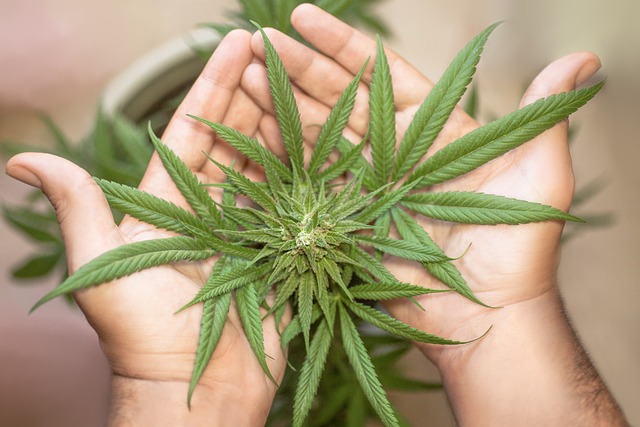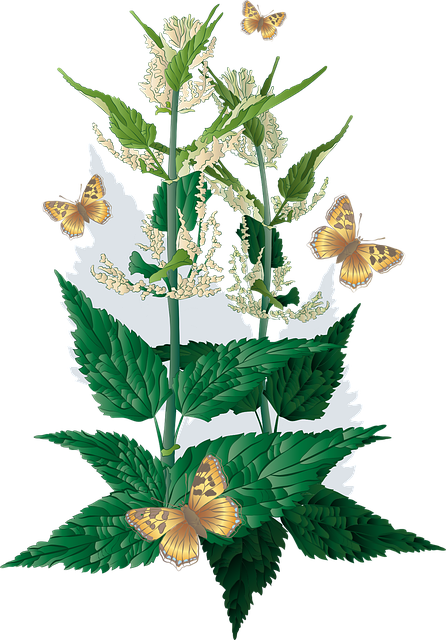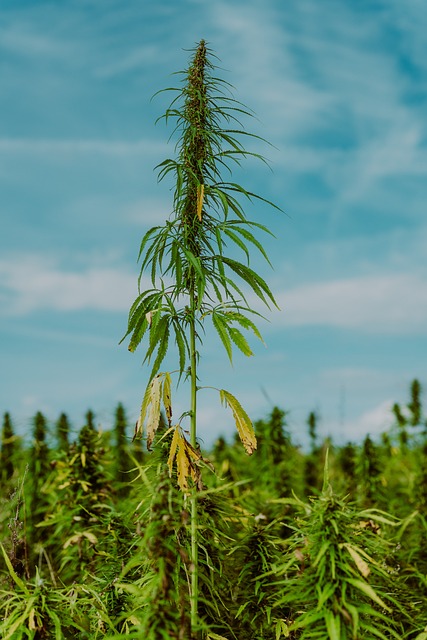Delta-9-tetrahydrocannabinolic acid A (THCA), a non-psychoactive component of raw cannabis flowers, is gaining attention for its potential as a therapeutic agent for pain relief due to its anti-inflammatory and analgesic properties. THCA interacts with the endocannabinoid system by binding to CB1 and CB2 receptors without inducing psychoactive effects, making it a valuable option for sensitive patients. Preliminary research and anecdotal user reports support its efficacy in alleviating various types of pain, including chronic and neuropathic conditions. As studies continue to elucidate THCA's mechanisms, its role in complementary and alternative medicine for pain management is becoming more apparent, offering a natural and psychoactive-free alternative to traditional pain medication. The importance of selecting high-quality THCA flower cannot be overstated, as its therapeutic benefits are maximized when cultivated and stored properly to maintain its potency. Proper storage in a cool, dark, and dry environment is essential to prevent degradation and ensure that the THCA flower remains effective for pain relief. Users are advised to opt for strains with high THCA content and to verify lab test results for purity and potency. The terpene profile, particularly myrcene, can also enhance the analgesic properties of the THCA flower. In essence, THCA flower is a promising natural remedy for pain management, provided it is handled and stored correctly from cultivation to consumption.
Explore the transformative potential of THCA flower as a natural remedy for pain management. This article delves into the science and applications of this non-psychoactive cannabinoid, offering insights into its analgesic properties and how it interacts with the human endocannabinoid system. From sourcing high-quality THCA flower to understanding its role in comprehensive pain therapy, we guide you through every facet, including optimal dosing strategies, legal considerations, and practical consumption methods. Join us as we unravel the mysteries of THCA flower for pain relief, drawing on real-life experiences and empirical research to provide a holistic view of this promising therapeutic option.
- Unveiling the Potential of THCA Flower in Pain Management
- The Science Behind THCA Flower and Its Analgesic Properties
- Understanding THCA: From Cannabis Plant to Potent Pain Reliever
- The Role of Endocannabinoid System in Modulating Pain and How THCA Flower Interacts with It
- Sourcing and Selecting High-Quality THCA Flower for Optimal Pain Relief
- Proper Storage and Handling to Maintain the Potency of THCA Flower
Unveiling the Potential of THCA Flower in Pain Management

The therapeutic potential of THCA flower, or tetrahydrocannabinolic acid, a non-psychoactive cannabinoid found in hemp and cannabis plants, has garnered significant attention within the realm of pain management. Research suggests that THCA interacts with the body’s endocannabinoid system, modulating pain signals and inflammatory responses. This interaction may offer relief from various types of pain, including chronic and neuropathic conditions. Unlike its psychoactive counterpart THC, THCA does not induce a ‘high’, making it a viable option for those seeking the analgesic properties of cannabinoids without mind-altering effects. Preclinical studies have indicated that THCA possesses anti-inflammatory and analgesic qualities, which may be beneficial in managing pain associated with conditions such as arthritis or musculoskeletal disorders. Its efficacy in pain relief is further supported by anecdotal evidence from patients who report substantial pain reduction when using THCA flower for pain relief. As research continues to evolve, the role of THCA flower in complementary and alternative medicine for pain management becomes increasingly clear, offering hope for those seeking natural alternatives to traditional pharmaceuticals.
The Science Behind THCA Flower and Its Analgesic Properties

Delta-9-tetrahydrocannabinol (THC) is well-known for its psychoactive effects, but before it undergoes decarboxylation—a process that occurs when cannabis is heated—there exists tetrahydrocannabinolic acid A (THCA). THCA is the raw, non-psychoactive precursor to THC found abundantly in raw cannabis flowers and is gaining attention for its potential therapeutic benefits, including analgesic properties. Scientific research suggests that THCA interacts with the body’s endocannabinoid system through its affinity for both CB1 and CB2 receptors. This interaction may contribute to the compound’s pain-relieving effects without the psychoactive impact of its decarboxylated counterpart. Preclinical studies have indicated that THCA can exert anti-inflammatory effects, which are believed to play a significant role in alleviating various types of pain. Additionally, THCA’s potential as an analgesic agent is supported by its ability to modulate neurotransmitter release and limit the production of pro-inflammatory mediators, offering a promising avenue for those seeking natural alternatives for pain relief. Consumers interested in exploring THCA flower for pain relief should consider the method of administration and the specific strain’s THCA content, as these factors can influence the compound’s efficacy and experience. As research continues to evolve, the role of THCA in pain management may become increasingly recognized and utilized.
Understanding THCA: From Cannabis Plant to Potent Pain Reliever

The cannabinoid THCA, or tetrahydrocannabinolic acid, exists within the raw cannabis plant and represents a precursor to the more well-known psychoactive compound THC. As the cannabis plant matures and is exposed to heat through processes like decarboxylation, THCA transforms into THC. However, THCA itself possesses unique therapeutic properties that have garnered attention in the realm of pain management. Research suggests that THCA interacts with the body’s endocannabinoid system, influencing pain sensation and inflammation response without the psychoactive effects associated with THC. This makes THCA an appealing option for those seeking natural pain relief.
Harvesting THCA-rich flowers from cannabis plants allows for the extraction of this cannabinoid in its raw form, preserving its full potential. These THCA flower buds are then utilized in various forms, including oils, capsules, and smokable products. The anti-inflammatory and analgesic effects of THCA are particularly beneficial for individuals suffering from chronic pain conditions such as arthritis or neuropathy. Unlike its psychoactive counterpart, THCA is also reported to offer neuroprotective benefits, which may further enhance its therapeutic value. As a result, the use of THCA-rich cannabis flowers for pain relief is becoming an increasingly popular and effective treatment option in medical cannabis programs across the globe.
The Role of Endocannabinoid System in Modulating Pain and How THCA Flower Interacts with It

The endocannabinoid system (ECS) is a pivotal regulatory network within the human body, responsible for maintaining homeostasis, particularly in relation to pain management. This complex cell-signaling system is composed of three core components: endocannabinoids, receptors, and enzymes. Endocannabinoids are naturally occurring compounds that resemble cannabinoids found in cannabis; they bind to cannabinoid receptors throughout the body, with CB1 receptors primarily found in the brain and nervous system, and CB2 receptors distributed in peripheral organs and cells. The interaction between these endocannabinoids and receptors helps regulate various physiological functions, including pain sensation and inflammation response. When the body experiences pain, the ECS can modulate this discomfort by influencing how pain signals are received and interpreted.
Entering into the realm of therapeutic applications, THCA (tetrahydrocannabinolic acid) flower has garnered attention for its potential role in pain relief. As a non-psychoactive precursor to THC (tetrahydrocannabinol), THCA interacts with the ECS by binding to both CB1 and CB2 receptors, albeit with a lower affinity than other cannabinoids like THC or CBD (cannabidiol). This interaction can lead to anti-inflammatory effects and analgesic properties, offering relief for those suffering from various types of pain. The anti-inflammatory action of THCA is thought to stem from its ability to inhibit pro-inflammatory cytokines and enzymes responsible for pain and inflammation. As a result, THCA flower for pain relief is a promising avenue for individuals seeking natural alternatives to manage their discomfort without the psychoactive effects typically associated with cannabis products containing higher levels of THC.
Sourcing and Selecting High-Quality THCA Flower for Optimal Pain Relief

When seeking high-quality THCA flower for pain relief, careful consideration in sourcing and selection is paramount. The THC acid, or tetrahydrocannabinolic acid, found in raw cannabis plants, exhibits therapeutic properties that can alleviate various types of pain. Reputable sources for THCA flower should be cultivators with a proven track record of high-standard farming practices and rigorous testing for potency and purity. These cultivars often undergo extensive processes to preserve the natural THCA content without exposing the plant to heat, which would convert THCA into its psychoactive form, THC.
Consumers should look for strains known for their high THCA content and pain-relieving effects, such as Harlequin or Sour Space Diesel. Additionally, lab test results should be readily available to confirm the presence of THCA and the absence of contaminants. The strain’s terpene profile also plays a crucial role in its efficacy for pain relief; myrcene, for instance, is often associated with analgesic properties and can enhance the plant’s natural therapeutic benefits. By adhering to these sourcing and selection guidelines, individuals can optimize their use of THCA flower for safe, effective pain relief.
Proper Storage and Handling to Maintain the Potency of THCA Flower

Proper storage and handling are critical in maintaining the potency and efficacy of THCA flower, particularly when it comes to using it for pain relief. THCA, or Tetrahydrocannabinolic Acid, is the raw form of THC found in cannabis plants and has been noted for its potential analgesic properties. To preserve its therapeutic benefits, it’s essential to protect the THCA from degrading factors such as light, heat, and humidity.
Optimal storage conditions involve keeping the THCA flower in a cool, dark, and dry place. Airtight containers made of glass or opaque materials are ideal for this purpose as they prevent exposure to oxygen and light, which can accelerate the degradation of cannabinoids. The temperature should be consistently low, ideally between 55°F and 65°F (13°C to 18°C), to slow down any potential chemical changes that could diminish the flower’s effectiveness for pain relief. Regularly inspecting your THCA flower for any signs of mold or dryness and adjusting storage conditions accordingly will further ensure its integrity for when it’s needed most. Proper handling, from harvest to final use, is also a factor in retaining the natural properties of the THCA flower, ensuring that consumers can rely on its pain-relieving benefits as intended.
THCA flower emerges as a promising modality in the realm of pain management, offering a natural alternative for those seeking relief. The intricate science behind its analgesic properties and interactions with the endocannabinoid system provide a compelling case for its potential benefits. Conscientious sourcing and selection of high-quality THCA flower are paramount to ensure its efficacy in alleviating pain. With proper storage and handling, individuals can maintain its potency, making THCA flower a valuable option for those exploring holistic approaches to pain relief. As research continues to unfold, the integration of THCA flower into therapeutic practices may offer significant benefits, underscoring the importance of this topic in expanding our understanding of cannabinoids and their applications in health and wellness.
